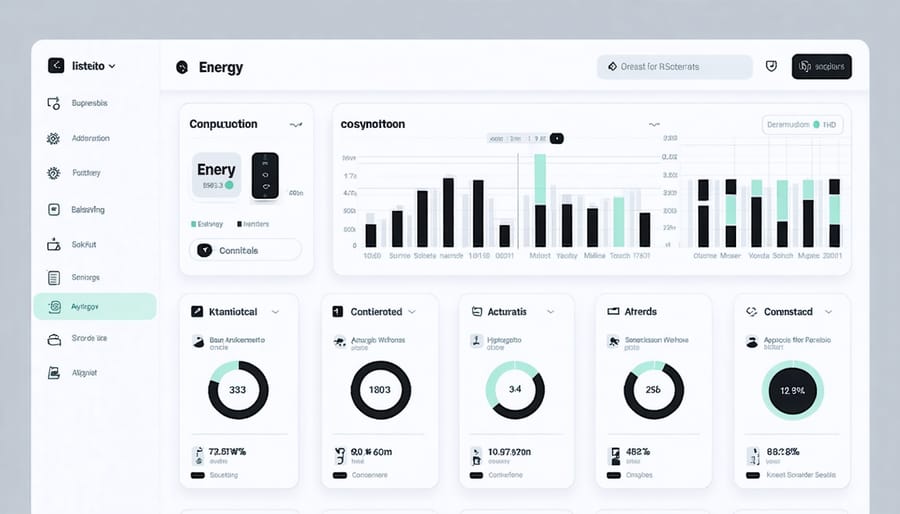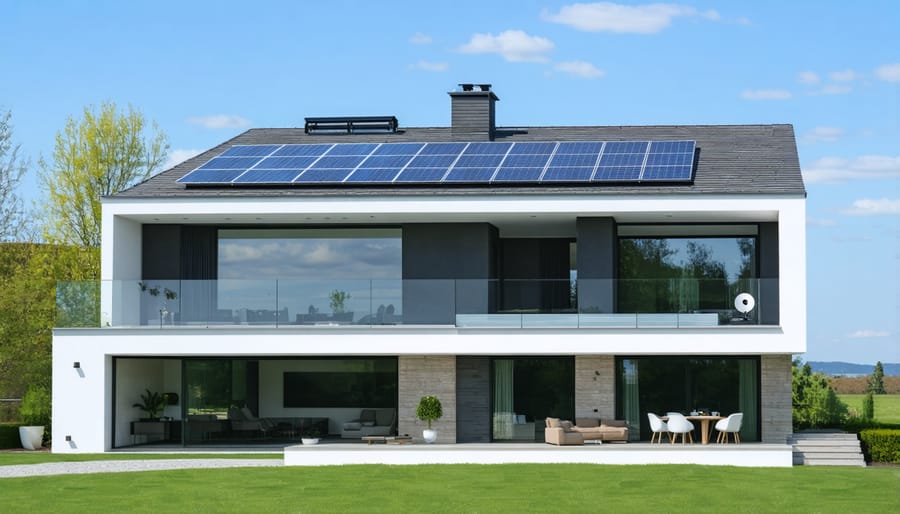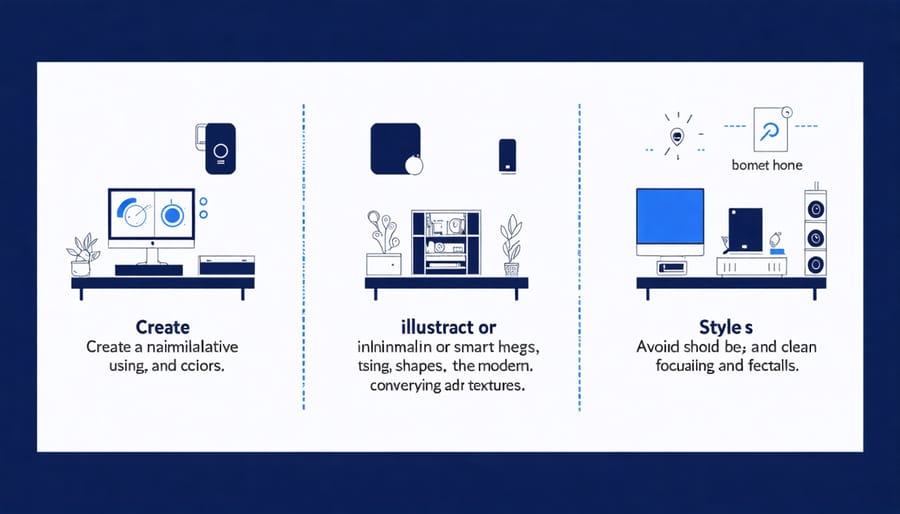Transform your home into an energy-efficient sanctuary while protecting our planet’s future. Today’s smart technologies and sustainable practices make it easier than ever to reduce both your carbon footprint and monthly utility bills. From smart thermostats that learn your schedule to energy-efficient appliances that slash power consumption, the path to sustainable living starts right at your doorstep.
Every watt saved contributes to a greener tomorrow, and the benefits extend far beyond environmental impact. Homeowners implementing energy-efficient solutions typically see a 20-30% reduction in energy costs while increasing their property value. Whether you’re renovating your entire home or starting with small changes, sustainable energy practices offer immediate returns and long-term advantages.
The intersection of energy efficiency and sustainability represents more than just a trend – it’s a fundamental shift in how we think about home comfort and resource management. By embracing these principles, you’re not just creating a more comfortable living space; you’re investing in a sustainable future while enjoying significant cost savings along the way. Let’s explore how you can make your home more energy-efficient while contributing to a more sustainable world.
The Foundation of Smart Home Energy Efficiency
Smart Thermostats: The Control Center
Smart thermostats are revolutionizing how we manage our home’s climate and energy use. These intelligent devices learn your schedule and preferences, automatically adjusting temperatures to optimize both comfort and efficiency. Unlike traditional thermostats, they offer remote control through smartphone apps, letting you adjust settings from anywhere – perfect for those unexpected schedule changes.
What makes these devices truly “smart” is their ability to analyze your heating and cooling patterns. They create customized schedules based on when you’re home, asleep, or away, potentially saving 10-15% on your energy bills. Many models also feature occupancy sensors that detect when rooms are empty and adjust accordingly.
Weather-responsive programming is another game-changing feature. These thermostats monitor local weather conditions and adapt your home’s temperature accordingly. They’ll even send you energy reports and maintenance reminders, helping you track savings and keep your HVAC system running efficiently.
The best part? Most smart thermostats are surprisingly easy to install and use. With intuitive interfaces and step-by-step setup guides, you can start saving energy within hours of installation. Some models even qualify for utility company rebates, making them an even smarter investment for your home.
Automated Lighting Systems
Automated lighting systems are revolutionizing the way we manage our home’s energy consumption. By combining motion sensors, timers, and smart controls, these systems ensure lights are only on when needed, potentially cutting your lighting energy usage by up to 50%.
The beauty of modern automated lighting lies in its simplicity and flexibility. Motion sensors can automatically illuminate walkways and rooms as you enter, then turn off after you leave. Smart schedules can mimic occupancy while you’re away, enhancing security without wasting energy. Many systems also offer daylight harvesting, automatically adjusting artificial light levels based on available natural light.
Setting up an automated lighting system doesn’t have to be complicated. Start with smart bulbs in high-traffic areas like your kitchen and living room. Add motion sensors in bathrooms and hallways, where lights are often left on accidentally. For outdoor spaces, combine motion detection with dawn-to-dusk sensors to ensure security lighting only operates when necessary.
The best part? Many of these systems can be controlled right from your smartphone, making it easy to monitor and adjust your lighting usage wherever you are.
Advanced Energy Management Features

Real-Time Energy Monitoring
Ever wondered how much energy your home actually uses at any given moment? Real-time energy monitoring is like having a fitness tracker for your home, giving you instant insights into your energy consumption patterns. With modern energy monitoring and control systems, you can track your usage down to individual appliances and rooms.
These smart tools display your energy consumption through user-friendly apps or wall-mounted displays, making it easy to spot energy-hungry appliances or unusual spikes in usage. Imagine seeing exactly how much electricity your washing machine uses during each cycle, or discovering that your old freezer is consuming twice the energy it should!
The benefits go beyond just watching numbers tick by. Real-time monitoring helps you:
– Make informed decisions about when to run energy-intensive appliances
– Identify energy-wasting habits you might not have noticed
– Set personalized goals and track your progress
– Receive alerts when usage exceeds normal patterns
– Understand the impact of your energy-saving efforts
Many homeowners report saving 10-15% on their energy bills simply by becoming more aware of their consumption patterns. Think of it as having a personal energy coach, guiding you toward more sustainable habits while helping you save money. The best part? Most modern systems are surprisingly simple to install and use, making this an accessible first step toward a more energy-efficient home.
Smart Appliance Integration
Today’s smart appliances are revolutionizing how we manage home energy consumption, making it easier than ever to maintain an energy-efficient household. These connected devices do more than just basic tasks – they actively help you reduce your carbon footprint while keeping your utility bills in check.
Modern refrigerators, washing machines, and dishwashers now come equipped with Wi-Fi connectivity and smart sensors that optimize their operation based on actual usage patterns. For example, smart refrigerators can adjust their cooling cycles during off-peak hours, while intelligent washing machines can determine the perfect amount of water and energy needed for each load.
The real magic happens when these appliances work together through a central home automation system. Imagine your dryer automatically starting when electricity rates are lowest, or your dishwasher running its cycle when your solar panels are generating peak power. These smart features not only save energy but also make your daily routines more convenient.
Many of these appliances come with user-friendly apps that provide real-time energy consumption data and maintenance alerts. You can track your usage patterns, receive energy-saving tips, and even control your appliances remotely. Some models even learn from your habits, automatically adjusting their settings to maximize efficiency while maintaining comfort.
When shopping for smart appliances, look for Energy Star certification and compatible connectivity protocols that work with your existing home automation system. While these appliances might cost more upfront, the long-term energy savings and environmental benefits make them a smart investment for your sustainable home.
Sustainable Energy Solutions
Solar Panel Integration
Integrating solar energy systems into your home is one of the most effective ways to boost energy efficiency and sustainability. Today’s solar solutions are more affordable and sophisticated than ever, offering seamless integration with smart home technology to maximize your energy savings.
Modern solar panels can be connected to your home’s smart energy management system, allowing you to monitor production and consumption in real-time through your smartphone. This integration enables you to optimize your energy usage by automatically running high-consumption appliances during peak solar production hours.
The beauty of solar integration lies in its flexibility. You can start small with a few panels and expand your system over time. Many smart home systems now come with built-in solar compatibility, making it easier to connect your panels to other energy-saving devices like smart thermostats and automated lighting.
To get the most from your solar setup, consider installing a smart battery storage system. This allows you to store excess energy produced during sunny days for use during cloudy weather or at night. The latest smart inverters can even help you manage power flow between your panels, battery, and the grid automatically.
When planning your solar integration, work with certified installers who understand both solar technology and smart home systems. They can help you design a system that meets your energy needs while ensuring compatibility with your existing smart home infrastructure.

Energy Storage Solutions
Energy storage is becoming increasingly accessible for homeowners, offering smart ways to manage power consumption and reduce utility bills. Battery systems, similar to those used in electric vehicles, can now be installed in your home to store excess energy from solar panels or grid power during off-peak hours.
The most popular option is lithium-ion battery storage, which offers excellent performance and longevity. These systems can power your home during outages and help you maximize renewable energy usage by storing solar power for nighttime use. For a typical family home, a 10-13 kWh battery system usually provides sufficient backup power for essential appliances and lighting.
Smart power management systems work alongside these batteries to optimize energy usage. They automatically switch between stored power and grid electricity based on peak pricing periods, potentially saving you hundreds of dollars annually. These systems can also learn your household’s energy patterns and adjust accordingly, ensuring you’re always using power in the most cost-effective way.
Consider starting with a smaller battery system that can be expanded later. This approach allows you to test the benefits while managing initial costs. Many utility companies offer incentives for installing home battery systems, making the investment more affordable. Remember to work with certified installers who can help size your system correctly and ensure safe integration with your home’s electrical system.
Practical Implementation Tips

Starting Your Smart Home Journey
Embarking on your smart home journey doesn’t have to be overwhelming. By taking small, strategic steps, you can create an energy-efficient living space that saves money while contributing to a sustainable future. Let’s break down how to get started.
Begin with a home energy audit to identify areas where you’re losing energy. This baseline assessment will help you prioritize improvements and track progress. Many utility companies offer free audits, or you can use a DIY checklist available online.
Start with the basics: smart thermostats and LED bulbs. These are low-cost entry points that offer immediate energy savings. A programmable thermostat can reduce your heating and cooling costs by up to 10%, while LED bulbs use 75% less energy than traditional ones.
Next, consider smart plugs and power strips. These devices help eliminate “vampire energy” – the power electronics consume even when turned off. Connect them to your home’s WiFi to monitor and control energy usage from your smartphone.
As you become more comfortable with eco-friendly home solutions, expand your system by adding smart window coverings and occupancy sensors. These automate your home’s response to natural light and room usage, maximizing energy efficiency.
Remember to choose compatible devices that work with your preferred smart home platform (like Google Home or Amazon Alexa). This ensures seamless integration and easier management of your growing smart home ecosystem.
Start small, learn as you go, and gradually build up your system. The key is to make sustainable choices that fit your lifestyle and budget while moving toward a more energy-efficient home.
Maximizing Energy Savings
Ready to transform your home into an energy-saving powerhouse? Let’s explore some proven strategies that can make a significant difference in your energy consumption and utility bills.
Start with the basics by conducting a home energy audit. Check for drafts around windows and doors, inspect insulation quality, and identify energy-hungry appliances. This simple assessment will help you prioritize your efficiency improvements.
Smart thermostats are game-changers for energy management. Program your heating and cooling schedules around your daily routine, and take advantage of features like remote control and occupancy sensing. Many users report savings of 10-15% on their heating and cooling costs after installation.
Lighting choices matter more than you might think. Replace traditional bulbs with LED alternatives, which use up to 75% less energy and last 25 times longer. Install motion sensors in less-frequently used areas to ensure lights aren’t left on unnecessarily.
Here’s a pro tip: leverage natural light and heat. Open curtains during winter days to warm your space naturally, and close them during summer afternoons to keep the heat out. Strategic placement of trees and shrubs can provide natural shade and reduce cooling needs.
Don’t overlook your appliances’ energy settings. Running dishwashers and washing machines with full loads, using cold water when possible, and enabling power-saving modes can lead to substantial savings over time.
Remember, small changes add up. Unplugging electronics when not in use, using power strips for easy management, and regular maintenance of HVAC systems all contribute to long-term energy efficiency. Start implementing these strategies today, and watch your energy bills shrink while your comfort grows.
Taking steps toward energy efficiency isn’t just about reducing utility bills – it’s about creating a more sustainable future for generations to come. Throughout this guide, we’ve explored various ways to make our homes more energy-efficient, from simple DIY projects to more substantial improvements.
Remember that every small change matters. Starting with basic improvements like LED lighting, proper insulation, and smart thermostats can lead to significant energy savings. By implementing these changes gradually, you can transform your home into an energy-efficient haven without overwhelming your budget or schedule.
The benefits extend far beyond cost savings. Energy-efficient homes contribute to reduced carbon emissions, improved indoor comfort, and increased property value. Plus, many energy-efficient upgrades qualify for tax incentives and rebates, making them even more attractive investments.
Don’t feel pressured to implement everything at once. Start with one or two projects that align with your immediate needs and budget. Consider conducting an energy audit to identify your home’s specific needs and prioritize improvements accordingly.
The path to sustainability is a journey, not a destination. By taking action today and making conscious choices about our energy consumption, we’re investing in a better, more sustainable future. Every energy-efficient choice you make brings us one step closer to a greener planet.
Ready to start your energy efficiency journey? Pick one improvement from this guide and take action today. Your wallet – and the planet – will thank you.
